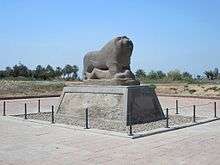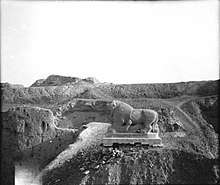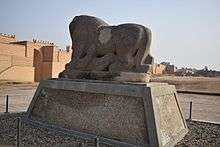Lion of Babylon (statue)
Lion of Babylon is a stone sculpture that was found in the ancient city of Babylon, Iraq.


History
It was discovered in 1876 by a German archaeological mission.
The Lion of Babylon is over 2600 years old.[1]
The statue was built by the Chaldean Babylonian king Nebuchadnezzar II (605-562 BC).[2]
The statue had been damaged over the years due to lack of protection, getting climbed on by tourists that left marks on the statue, or natural causes like erosion which Archaeologists had already feared was going to happen without the right protection of the statue.[3]
In 2013 The World Monuments Fund worked with the Iraq State Board of Antiquities to make improvements to the site. The Lion was cleaned and partially restored, the base of the statue was replaced, and a security barrier was added.[4]
Description
The statue is made out of black basalt black stone; it depicts a Mesopotamian lion standing above a laying human. The statue is two meters in length and the platform upon which it stands is one meter. The lion weighs about 7000kgs.
The statue height is 11.95 meters, and it is 2.6 meters long.[5]
Symbolism
The Lion of Babylon is a historic theme in the region. The statue is considered among the most important symbols of Babylon in particular and Mesopotamian art in general.[6] The statue is considered a national symbol of Iraq, it has been used by several Iraqi institutions such as the Iraqi Football Association.[7]
The lion was meant to put fear into their enemies, by showing a lion trampling a man to scare their enemies.[8]
It represented Ishatar, the goddess of fertility, love, and war.[9]
On the back of the lion is a representation of where Ishtar should stand.[10]
See also
- Ishtar Gate
- Lion Hunt of Ashurbanipal
- Lion of Basrah
- Mesopotamian lion
- Lion of Babylon
References
- Symbolism, MENA (2018-12-26). "The Lion of Babylon". MENA symbolism. Retrieved 2020-04-29.
- Zeed, Adnan Abu (30 June 2016). "Prized Lion of Babylon joins list of crumbling Iraqi antiquities". Al-Monitor. Retrieved 10 December 2018.
- "Ancient Iraq: Lion of Babylon - World Monuments Fund". Google Arts & Culture. Retrieved 2020-04-29.
- "Ancient Iraq: Lion of Babylon - Google Arts & Culture". Google Cultural Institute. Retrieved 10 December 2018.
- "Ancient Iraq: Lion of Babylon - World Monuments Fund". Google Arts & Culture. Retrieved 2020-04-30.
- "Babylon Chronicle, A 1932 photograph of the Lion of Babylon from the". Tammuz.tumblr.com. Retrieved 2016-03-30.
- "الاتحاد العراقي لكرة القدم". Ifa.iq. Retrieved 2016-03-30.
- "Lion of Babylon [Detail]". Ancient History Encyclopedia. Retrieved 2020-04-29.
- "Ancient Iraq: Lion of Babylon - World Monuments Fund". Google Arts & Culture. Retrieved 2020-04-29.
- "Babylon, Iraq". www.atlastours.net. Retrieved 2020-04-30.
